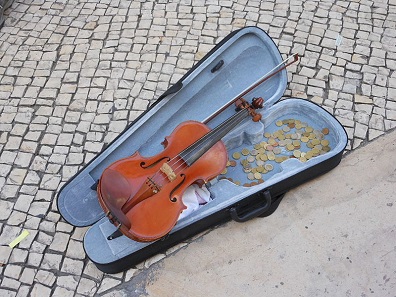by Annika Backe
June 29, 2017 – Italy will stop minting its 1- and 2-eurocents in 2018, as a parliamentary committee has decided in May 2017. It is said that this measure won’t affect the pricing of products and goods. When paid in cash, though, prices will be rounded to the nearest 5 cents.
The street musicians’ cases of instruments make a popular ‘collecting basin’ for all sorts of euro coins. Photo: Michael Coghlan / Wikimedia Commons / CC BY-SA 2.0
Tricky though this sounds in theory, it has become everyday reality in those countries that preceded Italy. In Belgium, Ireland, the Netherlands, and Finland, a bill of, let’s say, €1.98 is rounded up to 2.00 euros whereas for 1.97 euros only 1.95 euros have to be paid. This applies to cash transactions only. With debit or credit cards, the exact amount is charged. The initial fear of consumers, that this could induce concealed price increases, proved unsubstantiated.
Sergio Boccadutri, member of the ruling Democratic Party in Italy and driving force behind the legislation, told the media that his fellow citizens were stuck with their 1- and 2-eurocents. Received as small change in the shops, these smallest denominations of the euro were not accepted in parking meters, toll booths, or vending machines.
This action, however, won’t make the copper coins extinct. Although no longer manufactured, they will still serve as legal tender meaning that the trade is obliged to accept them.
A wealth of information on the euro is gathered on the website of the European Central Bank.
There, you can also find more details on the Italian euro coins.
And to learn about trends in payments in the U.S., for instance, please read The Federal Reserve Payments Study 2016.




